Alternate Route Handbook
6. Traffic Management Planning (continued)
Minimum Actions for Determining Information Dissemination Methods to Guide Motorists Along the Alternate Route
The task of determining information dissemination methods to guide motorists along the alternate route involves the following minimum actions: (1) deploy temporary trailblazer signs along the alternate route to guide motorists along the route, (2) specify the location of these signs in the alternate route plan, and (3) remove these signs upon discontinuing use of the alternate route. In areas with little or no ITS infrastructure, temporary static signs represent the main type of trailblazer sign used during alternate route implementation. In these areas, permanent trailblazers may be installed along planned alternate routes implemented on a frequent basis. If the trailblazers are used only when an incident occurs on the primary route, then the trailblazers should have the term "Detour" clearly labeled on each sign.
Ideal Actions for Determining Information Dissemination Methods to Guide Motorists Along the Alternate Route
The following ideal actions may be applied in addition to the minimum actions:
- Install permanent infrastructure (such as route marker signs with electronic changeable arrows or blank-out trailblazer signs) to guide motorists along designated alternate routes. Figures 6-5, 6-6, and 6-7 show examples of various types of signage along alternate routes. If two alternate routes overlap, then color-coded permanent trailblazers should be erected (see figure 6-8) to minimize confusion.
- Use temporary signs configured with a black legend on fluorescent pink background, as optionally assigned by the 2003 Manual on Uniform Traffic Control Devices (MUTCD)4 for traffic incident management area signs. Because the general public is not yet well aware of traffic control signs with a black legend on fluorescent pink background, as shown in figure 6-9, education and outreach are needed to inform the public about the meaning of these traffic incident management area signs.
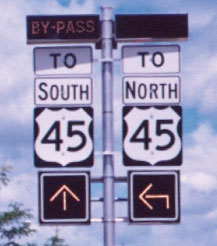 |
| Figure 6-5. Trailblazers with changeable arrow. (Source: Wisconsin DOT) |
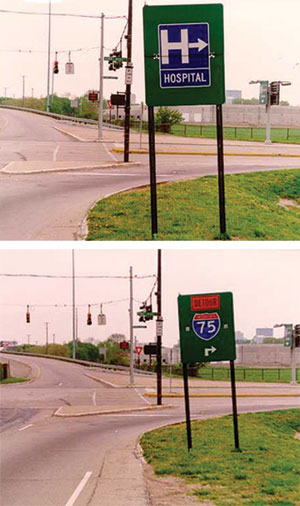 |
| Figure 6-6. Fold-out sign. (Source: Dayton, OH, Police Department) |
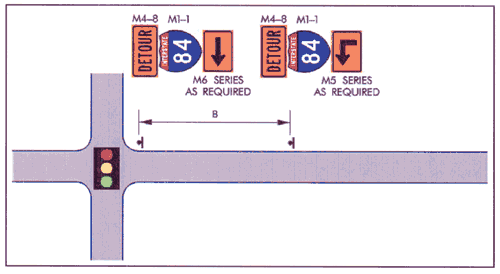 |
| Figure 6-7. Trailblazer signage at signalized intersection along alternate route. (Source: Idaho Transportation Department) |
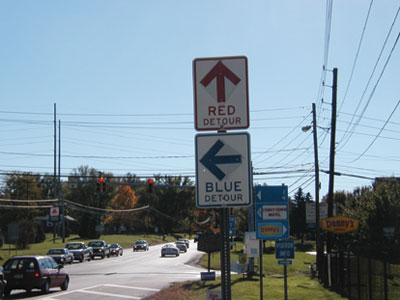 |
| Figure 6-8. Color-coded alternate route trailblazer signs. |
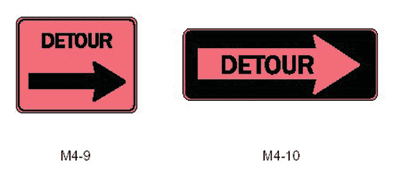 |
| Figure 6-9. Incident management traffic control signs. (Source: Federal Highway Administration4) |
DETERMINE TRAFFIC CONTROL MEASURES TO BE IMPLEMENTED ON THE ALTERNATE ROUTE
Agencies may implement specific traffic control measures along the alternate route to accommodate increased traffic demand during the implementation of an alternate route.
Typical traffic control techniques used on alternate routes to accommodate increased demand include:
- Law enforcement control.
- Modified traffic signal timings to provide additional green time to the alternate route.
- Ramp metering override to prevent long queues.
- Suspension of tolls.
- Suspension of HOV restrictions.
- Suspension of roadwork activities along the alternate route.
- Enforcement of parking restrictions along the alternate route.
- Alternative lane operations.
A basic form of traffic control involves having a law enforcement officer directing traffic. The officer controls traffic based on real-time roadway conditions. This is especially useful at signalized intersections where signal timing plans cannot be implemented in real-time to accommodate the additional diverted traffic. In addition, traffic control officers can facilitate protected alternate route turning movements (e.g., left turns) at intersections that otherwise function as low-capacity permitted turns.
One of the most effective and unintrusive methods of traffic control is modifying traffic signal timing plans. Most traffic signal controllers allow multiple programs to be set, and in some cases, timing may be set remotely from a transportation management center (TMC). Stakeholders may create a special alternate route signal timing plan in conjunction with alternate route plan development. Most traffic signal controllers also allow an operator to override the normal program manually, and if the controller is linked to a central system, then manual control can occur from a remote location.
When large numbers of diverted vehicles attempt to merge onto a freeway, regular ramp meter timing may create long queues, which may spill back onto local streets. Most ramp metering controllers allow either queue override or queue adjustment to flush the queue and allow vehicles to enter the freeway. Queue override temporarily suspends ramp metering, while queue adjustment temporarily increases the metering rate to allow more vehicles to enter.
Toll plazas require motorists to stop to pay a toll and, in turn, may represent a major bottleneck location under heavy traffic demand conditions. This is less of a problem with electronic toll collection (ETC); however, many motorists do not have ETC tags. To alleviate this bottleneck, the toll agency may choose to waive tolls along an alternate route so that the toll plaza does not constrain traffic and cause congestion.
Freeways may have an HOV lane, while streets may have a bus-only lane. HOV lanes are typically open only to buses or cars with two or more occupants. It may be useful to suspend HOV or bus restrictions along an alternate route so that the additional capacity can accommodate additional traffic volume.
There are also a few simple initiatives that may be used to improve capacity along an alternate route. If any roadwork activities exist along the alternate route, then the work should be suspended, if possible, to minimize the loss in capacity due to this activity. If parking restrictions exist along an alternate route, then law enforcement should strictly enforce these parking restrictions.
Some roadways may have reversible lanes, to allow extra lanes in the peak travel direction. Alternative lane configurations may be used on these roads to allow extra lanes in the direction of the alternate route.
Table 6-4 describes the role of stakeholders involved in developing traffic control initiatives to increase the traffic handling capacity of an alternate route.
Table 6-4. Stakeholder involvement in determining traffic control measures to implement on alternate route
| STAKEHOLDER | ROLE |
|---|---|
| Transportation/ public works agency |
|
| Law enforcement |
|
| Transit agency |
|
| Turnpike/toll authority |
|
Minimum Actions for Determining Traffic Control Measures to be Implemented on the Alternate Route
Minimum actions for determining traffic control measures to be implemented on the alternate route include:
- If congested conditions develop at signalized intersections, then manually override signal control or modify the existing traffic signal timing plan. Associated considerations include:
- Because the alternate route will carry more traffic than usual, congestion may develop at major intersections. Traffic signal timing at these intersections should be modified to favor traffic on the alternate route, if possible, while maintaining good coordination on the alternate route with adjacent signals.
- Traffic control officers may be required to direct traffic at a critical bottleneck point. Figure 6-10 shows an example of signage used when a flagger directs traffic along an alternate route. Figure 6-11 illustrates an example of a route narrative, describing the type of traffic control needed at key intersections along an alternate route during its implementation.
- Agencies may consider adding button-activated traffic signals along alternate routes to allow law enforcement personnel to control the traffic signal.
- Because the alternate route will carry more traffic than usual, congestion may develop at major intersections. Traffic signal timing at these intersections should be modified to favor traffic on the alternate route, if possible, while maintaining good coordination on the alternate route with adjacent signals.
- Suspend roadway activities, if possible, along the alternate route to minimize the loss in capacity. Roadwork activities significantly reduce capacity on a roadway, due to closed or narrowed lanes, side friction, and capacity used by construction vehicles and personnel. If possible, any roadwork activity along the alternate route should be suspended to minimize any loss in capacity.
- Enforce parking restrictions along the alternate route. Parking may significantly reduce capacity on a street, due to the space taken by parked vehicles, side friction, and parking maneuvers. If any parking restrictions exist along an alternate route, law enforcement should strictly enforce these restrictions, including immediate towing of vehicles in violation, when the alternate route plan is implemented.
- Control ramp operations at alternate route connection points with a freeway facility. Regarding a freeway-to-freeway or a freeway-to-street alternate route, potential bottleneck points are often freeway exit and entrance ramps or a street segment connecting two freeways. If congested conditions develop at these bottlenecks, then law enforcement may control the ramps or streets to ensure efficient operation (e.g., minimize vehicle headways, provide additional ramp lanes, eliminate weaving areas).
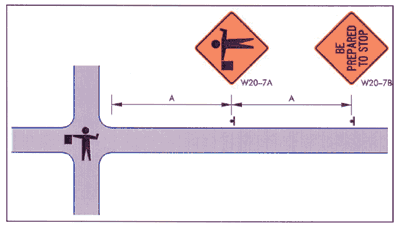 |
| Figure 6-10. Standard signing plan for flagger-controlled intersection. (Source: Idaho Transportation Department) |
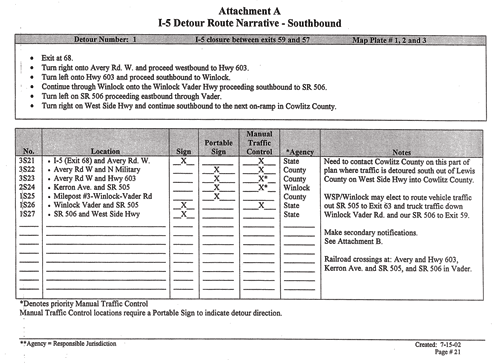 |
| Figure 6-11. Alternate route narrative. (Source: Washington State DOT) |
Ideal Actions for Determining Traffic Control Measures to be Implemented on the Alternate Route
The following ideal actions may be applied in addition to the minimum actions.
- If congested conditions develop at signalized intersections consisting of a computer-based traffic signal control system, then implement special traffic signal timing plans from the traffic operations center to support field traffic control. Associated considerations include:
- Existing traffic signal timing plans are often unable to accommodate the increase in traffic volume caused by diverted traffic. For this reason, it may be necessary to modify traffic signal and system timing to accommodate alternate route traffic volumes. Ideally, traffic signal timing should be controlled centrally from a TMC. At some intersections, law enforcement control may be needed for monitoring and intermittent manual timing control.
- Techniques that may be used to improve traffic flow for an individual intersection movement that services alternate route traffic include:
- Selecting an existing signal timing plan with a longer cycle length to increase the green time given to the phase that services alternate route traffic.
- Implementing a custom timing plan that favors the alternate route movement.
- Deploying a contingency "flush" plan, consisting of an extra long phase or cycle, to facilitate movement through the alternate route corridor.
- Increasing green time for the alternate route movement through manual traffic signal system operator or on-site officer/technician control.
- Selecting an existing signal timing plan with a longer cycle length to increase the green time given to the phase that services alternate route traffic.
- Existing traffic signal timing plans are often unable to accommodate the increase in traffic volume caused by diverted traffic. For this reason, it may be necessary to modify traffic signal and system timing to accommodate alternate route traffic volumes. Ideally, traffic signal timing should be controlled centrally from a TMC. At some intersections, law enforcement control may be needed for monitoring and intermittent manual timing control.
- Use traffic optimization tools to determine the optimal traffic signal timing plans. The FHWA Traffic Analysis Tools Primer5 provides guidance as to which types of traffic analysis tools to use for developing new traffic signal timing plans. Traffic optimization tools are used to develop optimal signal phasings and timing plans for isolated intersections, arterial streets, and signal networks.
- If any tolls exist along the alternate route, then suspend tolls during operation of the alternate route. Motorists can incur substantial delay at tollbooths. Although this is less of a problem with ETC, not all motorists have an ETC tag. If the traffic is being diverted from a tollway and traffic is forced to exit, delays incurred at the tollbooth may counter the alternate route time savings. In this case, it is best to suspend tolls at the exit point. Also, if traffic is diverted onto a tollway from a no-cost facility, tolls should also be suspended.
- If the road that traffic is diverted to is an HOV facility or has an HOV lane, then temporarily suspend HOV restrictions to allow all vehicles to use the alternate route. Associated considerations include:
- Some roadways may have an HOV lane open only to buses and carpools. If the HOV lane is not obstructed by the incident, then HOV restrictions can be lifted so that all traffic may use it as an alternate route. An alternate route consisting of an HOV lane(s) on or adjacent to a primary route represents the most efficient alternate route operation possible, provided that the alternate route offers sufficient capacity.
- Some roadways may have a high occupancy/toll (HOT) lane. In a HOT lane, single occupancy vehicles (SOVs) must pay a toll, while HOVs may travel at no cost. In a HOT lane, the tolls for SOVs may be suspended.
- The lifting of HOV restrictions should be communicated through CMSs, HAR, and the media. Law enforcement personnel should be stationed at alternate route entry points to facilitate diversion.
- Some roadways may have an HOV lane open only to buses and carpools. If the HOV lane is not obstructed by the incident, then HOV restrictions can be lifted so that all traffic may use it as an alternate route. An alternate route consisting of an HOV lane(s) on or adjacent to a primary route represents the most efficient alternate route operation possible, provided that the alternate route offers sufficient capacity.
- Suspend or modify the timing of ramp meters to prevent excessive queues on the roadway upstream of the primary route. Many ramp metering algorithms have built-in queue adjustment or queue override functions. When pre-timed ramp metering is used, ramp meters can cause excessive backups because they are not timed to accommodate excessive traffic demand. Many ramp metering algorithms have a built-in queue adjustment algorithm (where more cars are allowed through) or queue override (where ramp metering is suspended until the queue dissipates) that would be automatically invoked in these situations. If ramp metering controllers do not have this feature, then ramp meters should either be modified or suspended.
- If the alternate route has lane control signals, then modify signal indications to allow extra lanes in the direction that the alternate route is being used. Some roads have signals that control lane use, and these signals typically, under day-to-day operation, allow an extra inbound lane during the morning peak and an extra outbound lane during the afternoon peak. When an incident blocks travel lanes on a road with lane control signals, the normal lane control pattern may be adjusted to allow extra lanes in the capacity-constrained direction. Lane control signals on freeways are usually accompanied by a moveable barrier that delineates the start/end of freeway express lanes. Express lane operation in the opposite direction would require termination before the barrier is moved.
- Evaluate the traffic control plan using computer traffic simulation. Simulation is a powerful tool for evaluating alternate routes when field studies are not feasible. In order to ensure that the traffic control plan actually improves traffic, stakeholders should use computer traffic simulation to evaluate the effectiveness of traffic control plan strategies prior to actual implementation in the field. Stakeholders should revise the traffic control plan, as necessary, based on simulation results.
References
- Portable Changeable Message Sign Handbook, Federal Highway Administration, Report No. FHWA-RD-03-066, Washington, DC, 2003 [Online]. [December 19, 2003].
- 511: America's Travel Information Number: Implementation and Operational Guidelines for 511 Services, Version 2.0, American Association of State Highway and Transportation Officials, Washington, DC, September 2003 [Online]. [January 20, 2004].
- Guidelines for Changeable Message Sign Messages, Federal Highway Administration, Washington, DC, September 2002.
- Manual on Uniform Traffic Control Devices, 2003 edition, Federal Highway Administration, Washington, DC, 2003 [Online]. [December 31, 2003].
- Traffic Analysis Tools Primer, Federal Highway Administration, Washington, DC, January 2003.